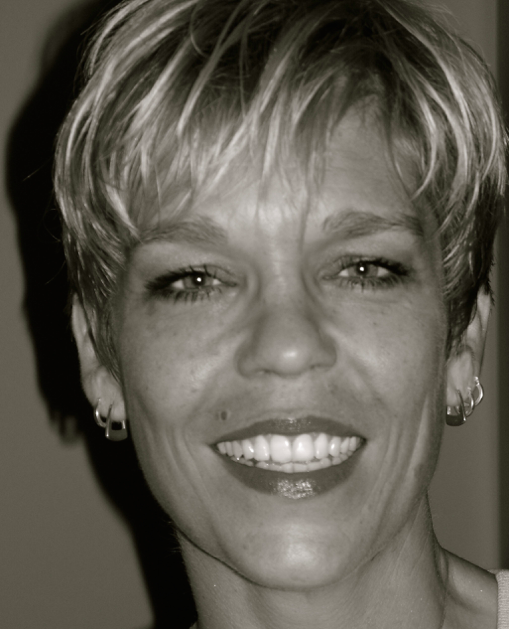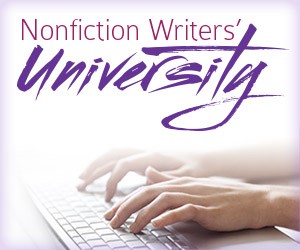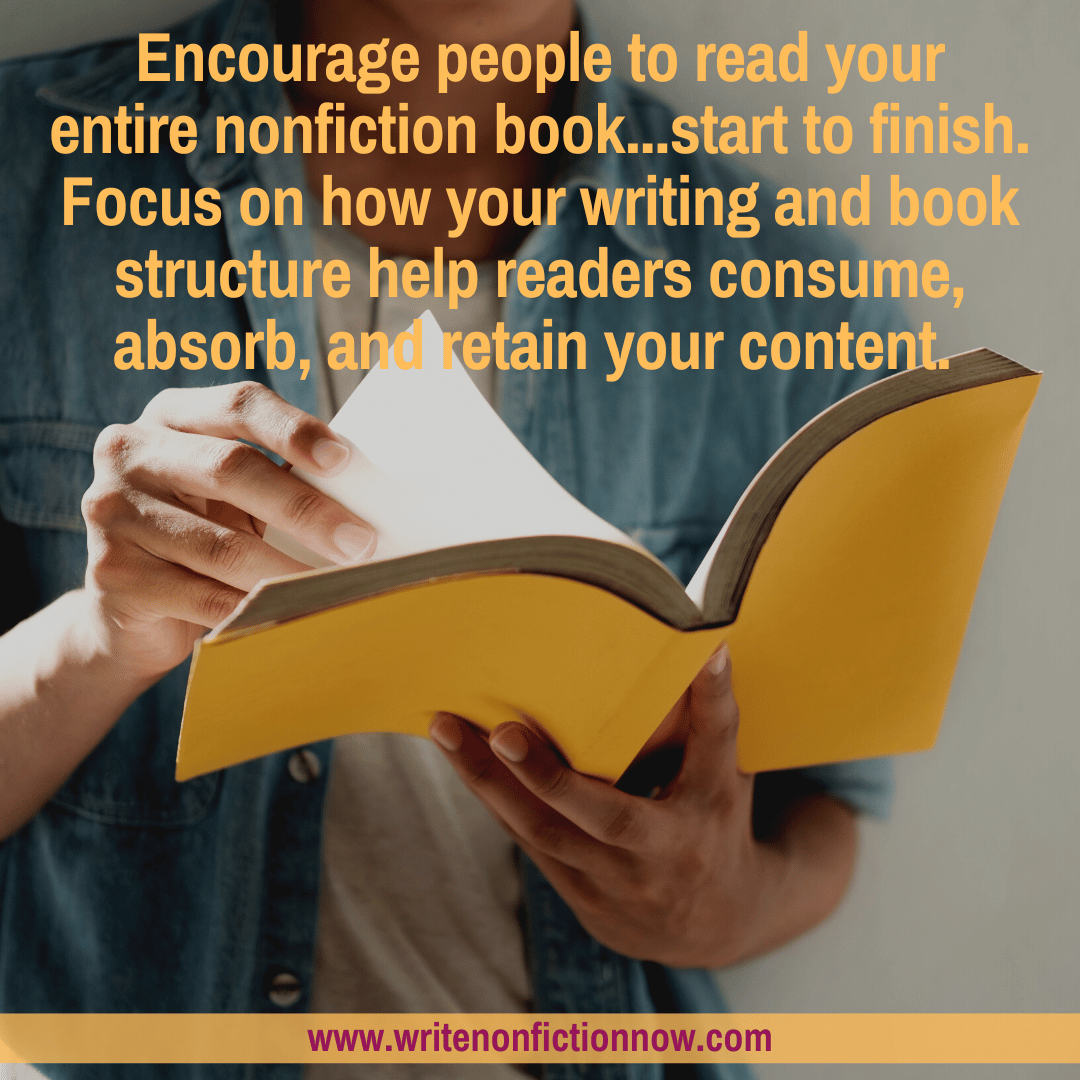When I read nonfiction books, I always intend to start at the beginning and read through to the end. But it doesn’t take long until I skip about and cherry-pick the chapters that appeal to me most. I know I’m not the only nonfiction reader who reads this way.
But you may not want readers to skip around. As the author, you likely want them to read from start to finish.
To minimize the number of readers that don’t read from cover to cover, you must organize your content in a manner that helps them navigate your book. A strong book structure and content plan also stop them from getting overwhelmed by the wealth of information, tips, and advice in your book.
So, how do you organize for reader navigation? You have multiple guideposts at your disposal that can be incorporated into your writing process. And you can put them to use as soon as you start writing your nonfiction book.
How to Structure Your Book
Early in my corporate career, I was given some advice to help me structure my presentations, and I’ve used this same advice to write books. It’s a simple three-step approach:
First Step: Tell them what you’re going to tell them.
Second Step: Tell them.
Third Step: Tell them what you just told them.
I’ve heard the same advice offered for writing personal essays.
A strong work of fiction needs a beginning, middle, and end. Your nonfiction book is no different; these elements are just presented a little differently.
Step 1: Tell Them What You’re Going to Tell Them
Multiple elements are used to convey your book’s focus and intent in a book. Readers use these elements to help them determine whether a book is relevant enough to buy.
Just as there are different ways readers consume your books, there are other approaches you can take when writing your book. For example, are you a plotter or a pantser?
Plotters plan out how they will blog their books into chapters, including the headings and subheadings. As a result, they know precisely what they plan to tell their readers.
Whereas pantsers just start writing and deal with the organization after creating a loose first draft. They may or may not be entirely clear on what they plan to share with their readers when they begin writing.
No matter which approach you take, eventually you’ll need a synopsis. And it’s better to have one when you begin writing if you want to keep readers moving through your book systematically.
Your Synopsis:
This high-level overview outlines what your book is about and summarizes its contents.
If you don’t have a book outline before you begin writing, you could end up writing content that’s not relevant. Your synopsis acts like a compass to keep your manuscript on track . But that’s not a synopsis’ only purpose.
Your synopsis is probably one of your book’s most hard-working elements. Ironically, it’s one of the shortest book elements. Still, it’s often the most difficult to write and needs the most editing. You’ll use your synopsis as a key part of your online marketing, and most nonfiction books include a version on the back cover.
A synopsis, typically found on the back cover, is one of the first interactions readers have with your book. It’s the hook that piques their interest, and it can be the deciding factor when it comes to choosing whether they’re going to flip open the front cover to venture within.
To find examples of an effectively written synopsis, visit your local bookstore and look at the titles within your niche. Then read what’s written on the back cover. You also can access a back-cover view on an online marketplace, like Amazon, or read the synopsis shown on the book’s sale page.
Your Introduction:
This section of your book focuses on your content’s subject matter and includes elements critical for your reader’s understanding of your topic. Here you include content readers need to be aware of before they continue reading. You can use this section to clarify your perspective, explain how you’re approaching the topic, or organize the content.
There are two levels of introduction in your book—overall and content segment. Your book’s introduction is included in your book’s front-matter, and the secondary level of introduction is at the chapter level.
Your book should include an introduction at the beginning. Whereas your synopsis is something you create before you begin writing, you may not be able to write an effective book introduction until you’ve written your book and finalized the flow of chapters and content.
You also can include chapter-level introductions so your chapters can stand alone.
Once you pique a reader’s interest, the next stop is your book’s introduction. After reading it, they should be confident that your book is relevant and can help them. Your chapter introductions will help readers who bought your book to skip around chapters more easily and read a summary of particular sections.
Note: Don’t confuse an introduction with a preface. Your preface is nice to have but not essential and doesn’t include critical information for your reader’s understanding of the book. Whereas an introduction is a crucial component.
Step 2: Tell them
This is the guts of your book, where you accompany your readers through their journey. Transformational books lead readers through a step-by-step process to achieve their goals. This content is book ended with an introduction and a conclusion. Basically, you actually tell them what you promised to tell them. If you do this well, they will read from start to finish.
Whether you plan your book out before beginning to write or just wing your content, you don’t have to write in the same order as it will be included in your book. Even if you’ve written a laundry list of all the topics you plan to cover, you have the option of jumping around that list to write in the order that inspires you most. However, if you are writing about a process or system, you may need to include that foundational information in logical order. And writing it in that order can help readers read in that order, too.
The order of your content becomes important when you put all the pieces together into a finished manuscript. For each nonfiction book I’ve written, the content order of the published book always looks different than the initial outline. Each round of editing seems to produce a better way of streamlining the content that could improve the reader’s experience and help them get from start to finish.
Your book can provide readers with a systematic approach to consume the content, and you can deliver it in bite-size chapter chunks. Headings and sub-headings help them scan your content. Tables, charts, pictures, and lists provide a visual variance from the straight narrative. These help to explain or stress an important point and have the power to stop readers in their tracks.
Step 3: Tell Them What You Just Told Them
Your readers won’t remember everything they just read. Some studies have shown the recall percentage can be as low as 20%. So, a conclusion offers an effective tool to summarize the key points you made throughout the book that you are eager for them to absorb.
You can include a summary paragraph to wrap up each chapter. You can use these to recap your main points. You might also find these summaries become useful when writing your conclusion.
Your book’s conclusion is another section that you won’t be able to write until you’ve finished your book manuscript. It’s an opportunity to reiterate key points and provides a last dose of inspiration for your readers to explore the topic in more detail. Do both these things, and you’ll encourage them to start putting their newfound skills and knowledge into action.
Readers of transformational or how-to books often struggle with information overload. Without a conclusion, they may be concerned they’ve missed some key concepts (especially if they jumped around the book rather than reading it systematically). Your conclusion provides reassurance they’ve read and absorbed your fundamental concepts and highlights any they may have missed.
Whether you’re writing from scratch or revising the final draft of your book, your audience needs to be at the forefront of your mind. Focus on how your writing and content structure help your readers consume, absorb, and retain your content. Then they’ll be more likely to achieve the results your book promises and read it from start to finish.
What techniques have you used to help your readers navigate your books? Leave a comment below, and please share this post with a friend.
About the Author

Jay Artale abandoned her corporate career to become a digital nomad and full-time writer. She’s an avid blogger and a nonfiction author helping travel writers and travel bloggers achieve their self-publishing goals. Join her at Birds of a Feather Press where she shares tips, advice, and inspiration to writers with an independent spirit.
 Would you like to write and publish nonfiction work, like articles, blog posts, books, or reports…and become a successful author? Join the Nonfiction Writers’ University. Get the basic education you need and the group Author Coaching to help you succeed as a nonfiction writer.
Would you like to write and publish nonfiction work, like articles, blog posts, books, or reports…and become a successful author? Join the Nonfiction Writers’ University. Get the basic education you need and the group Author Coaching to help you succeed as a nonfiction writer.
Enjoy a 30-day trial membership for only $1. If you’ve felt the desire to get coached and be supported as you pursue authorship, this program is for you. Participate in monthly group Author Coaching sessions and gain access to an extensive archive of writing and publishing resources.
Photo courtesy of msgrafixx.
